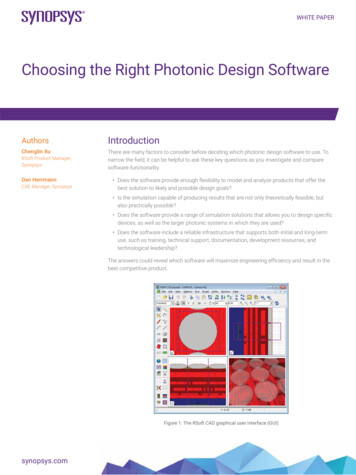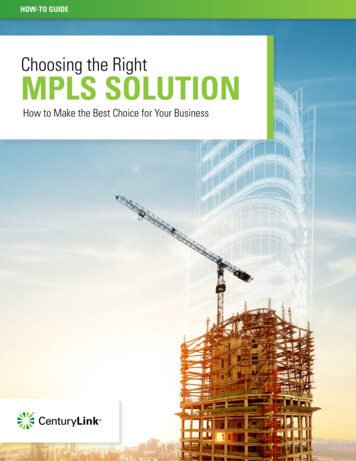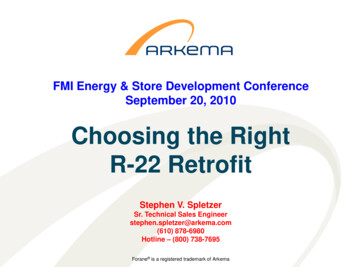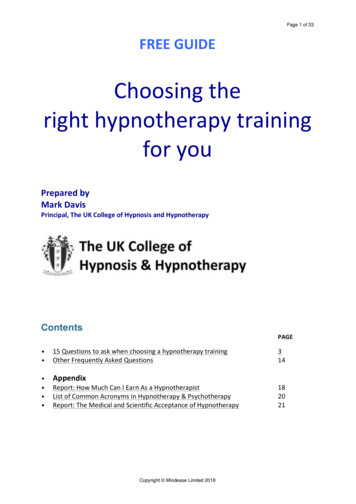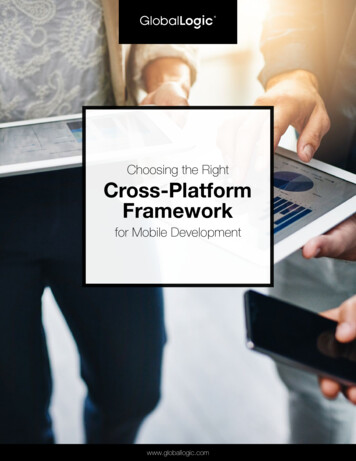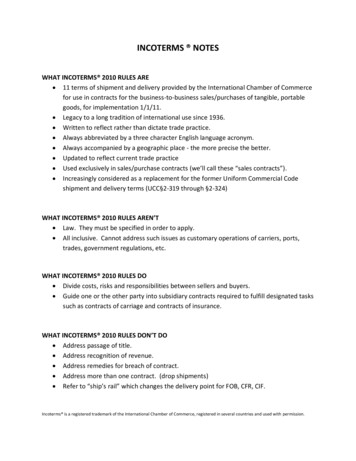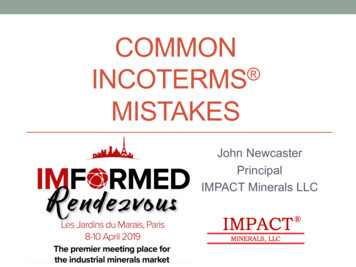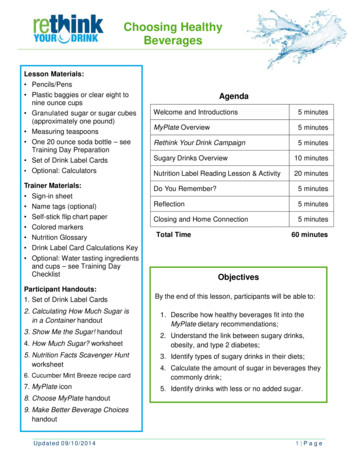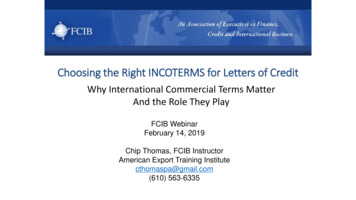
Transcription
Choosing the Right INCOTERMS for Letters of CreditWhy International Commercial Terms MatterAnd the Role They PlayFCIB WebinarFebruary 14, 2019Chip Thomas, FCIB InstructorAmerican Export Training Institutecthomaspa@gmail.com(610) 563-6335
Agenda Understanding INCOTERMS 2010 What They AreHistoryRole in Global TradeMisconceptions Overview of Key INCOTERMS “E” Term “F” Term “C” Term Which INCOTERMS are the Best to Use For Control For Payment Case Studies Letter of Credit Documentary Collection Conclusion
About Chip Thomas 43 Years of International Trade Experience 22 Year Banking Career 27 Years Educating Exporters on How to Effectively usePayment and Financing Tools Lived Abroad for over 12 Years (Africa, Asia & Latin America) Passionate about teaching “Best Practices” in InternationalTrade: “What You Must Know to be Successful in theInternational Market Place.”
INCOTERMS 2010 History – Who Sets the Rules?International Chamber of Commerce (ICC)Founded 1919 in ParisInternational representatives from over 120 countriesConforms with WTO, U.N., G20Link: 2010.aspx
INCOTERMS 2010 – What they are & What they do3 Letter Acronyms to:Standardize global trade termsDefine ResponsibilityOutline costs included in each ruleReveal GapsDetermine Delivery Point
IINCOTERMS Misconceptions/ConfusionINCOTERMS Do Not:1. Determine Financing(You Want How Many Days to Pay?)2. Settle Breach of Contract3. Determine Carriage Contracts4. Provide for Intangible Goods or Services5. Transfer Legal Title or Ownership of Goods
Why So Much Confusion? Where is there Confusion? In the USA! Why? Because for decades there were no standardizedDomestic Shipping Terms! Because freight forwarders are only concernedwith Shipping related risks!As a result we had .
Typical Historic Domestic US TermsFOB Origin;FOB Origin; Freight Collect;FOB Origin; Freight Prepaid;FOB Origin; Freight Prepaid and Add;FOB Destination;FOB Destination; Freight Collect;FOB Destination; Freight Prepaid;FOB Destination; Freight Prepaid and Allowed
Clarification of Terminology Delivery:Where the risk of loss or damage to the goodspasses from the seller to the buyer. Carrier:The party with whom carriage is contracted. Ship’s Rail:The term has been eliminated for FOB, CFR and CIF. On Board:This replaces ship’s rail for FOB, CFR and CIF.
INCOTERMS 2010 OverviewRULES FOR ANY MODE OF TRANSPORTEx Works (EXW)Free Carrier (FCA)Carriage Paid To (CPT)Carriage and Insurance Paid To (CIP)Delivered at Terminal (DAT)Delivered at Place (DAP)Delivered Duty Paid (DDP)MARITIME (WATERWAYS) RULESFree Alongside Ship (FAS)Free On Board (FOB)Cost and Freight (CFR)Cost Insurance and Freight (CIF)
INCOTERMS 2010 – “E” TermsEXW (EX-Works):Seller:Informs the Buyer when and where the goods will be available.Provides Commercial Invoice, Packing List & Certificate of Origin.Buyer:Arranges all carriers.Executes all logistics and export documents.Obtains export and import licenses.Risk of loss or damage passes to the buyer when goods are loadedon the inland conveyance.Question: What Transport/Shipping Document is Involved?
INCOTERMS 2010 – “E” TermsEXW (EX-Works):Seller places goods at loading dock for “pick up” by the buyer.Seller supplies all needed documentation for export of goods tothe buyer.Best used only for domestic transactions.Can only be applied to the seller’s origin point.Best used for domestic transportation.Insurance is the responsibility of buyer after goods are loaded.Question: What Transport/Shipping Document is Involved?
INCOTERMS 2010 – “E” TermsEXW (EX-Works):Major problems if used with a Letter of Credit:Buyer is not required to disclose any export information ordetails regarding the export of the goods.The shipper will likely be required to present an AWB or OBL.Conflict! The EXW term is never involved with an AWB or OBL.Risk: Seller’s inability to control the shipping document forpayment.Result: Possibility of a Total Loss!Question: What Transport/Shipping Document is Involved?
INCOTERMS 2010 – “F” TermsFCA: Free CarrierFOB: Free on BoardFAS: Free AlongsideAny Mode of Transport, All PackagingWaterway Only – LCL, Breakbulk,Barge or CharterMain carriage and all logistics is contracted by the buyer.Less responsibility for seller, more control for the buyer.Question: What Transport/Shipping Document is Involved?
INCOTERMS 2010 – “F” TermsFCA (Free Carrier) Named Place:Any Mode of TransportSELLER must deliver the goods to the CARRIER provided bythe BUYER at a named point/location.Seller documentation, costs & risks provided to named carrier.Revenue recognition available to seller at named point/carrier.Risks pass from seller to buyer upon delivery to first carrier.Buyer is responsible for transport costs, insurance and risksupon delivery of goods to the named carrier.Question: What Transport/Shipping Document is Involved?FCRAWBOBL
INCOTERMS 2010 – “F” TermsFOB (Free on Board):WATERWAY Term LCL, Breakbulk, Barge or CharterSELLER must deliver goods “on board” named vessel.Documentation, costs & risks up to goods “on board” are seller’s.Revenue recognition is available once B/L is released to seller.BUYER must give seller ample notice of vessel loading details.Transport costs, insurance and all risks are the responsibilityof the buyer once the cargo is “on board.”Insurance is the responsibility of buyer after goods are loaded.Question: What Transport/Shipping Document is Involved?
INCOTERMS 2010 – “F” TermsFAS (Free Along Side):WATERWAY Term LCL, Breakbulk, Barge or CharterSELLER must deliver goods “along side” named vessel.Documentation, costs & risks up to goods “along side” are seller’s.Revenue recognition is available once DR is released to seller.BUYER must give seller ample notice of vessel loading details.Transport costs, insurance and all risks are the responsibilityof the buyer once the cargo is “along side.”Question: What Transport/Shipping Document is Involved?
INCOTERMS 2010 – “F” TermsFAS (Free Along Side):
INCOTERMS 2010 – Container Shipment TermsFAS, FOB – Not Suitable for ContainersWATERWAY TERMLCL, Breakbulk, Barge or CharterWaterway terms are not suitable for containers.Why? Because with FAS, containers would be subject to penalties for delays ofloading, holding charges, vessel delays, etc. Since 2001 ports have implemented strict security, so FOB really can’toccur with containers since the port or carrier will actually do theloading “on board.”
INCOTERMS 2010 – “C” TermsCFR: Cost of Goods & Main FreightWATERWAY ONLYCIF: Cost of Goods, Main Freight & InsuranceCPT: Carriage Paid to Main PointCIP: Cost of Goods, Carriage & Insurance Paid to Named PointMain carriage and all logistics is controlled by the seller.More responsibility and control for the seller.Documentation, bank presentations, logistics, insurance & revenue recognition.Question: What Transport/Shipping Document is Involved?
INCOTERMS 2010 – “C” TermsCFR (Cost & Freight) – Named Port:WATERWAY only LCL, Breakbulk, Barge or CharterSELLER delivers goods to carrier for transport to named port.Revenue recognition passes upon seller receiving B/L.Risk transfers to buyer when goods are “on board” the vessel.BUYER is responsible for insurance, vessel unloading & allimportation formalities and costs.Question: What Transport/Shipping Document is Involved?
INCOTERMS 2010 – “C” TermsCPT (Carriage Paid to) – Named Point:Any Mode of TransportSELLER arranges & covers all costs up to named destination point.Revenue recognition passes upon seller receiving B/L.Risk transfers to buyer on delivery to the 1st carrier.Question: What Transport/Shipping Document is Involved?
What is the Best Rule to use for Your Transaction?Understand the INCOTERM Rules: Shipping Perspective Risk and Insurance Perspective Cost Perspective Control Perspective Revenue Recognition Perspective Documentation Risk Perspective Payment Risk Perspective
Exporting is a Cash Flow BusinessThis is Principal No. 1So .
An Important Question for All ExportersIf you are an international seller of merchandise,when do you want payment and when does yourbuyer want to pay?Answer:1. You:ASAP2. Buyer: As Late as Possible!So how to resolve this disparity of needs?
Understand Your Payment OptionsCash in Advance(No Documentation Risk)Letter of Credit(Major Documentation Risk)Documentary Collection(Major Documentation Risk)Open Account(No Documentation Risk)
Impact of INCOTERMS on Payments & ContractsOptionsDocumentary Letters of Credit (DLC)Documentary Collections (DC)
A Documentary LC is .A Payment MethodA Written Payment ArrangementA Written Payment ContractIt Assures Payment to Beneficiary if BeneficiaryPerforms Correctly by Presenting “ComplyingDocuments” to the Banks After Shipment(Documentary LC)
What is a Documentary Collection?A method of Collecting Funds from internationalbuyers by utilizing the services of banks.
Documentation & Payment IssuesIncorporate Incoterms into Sales Agreements /ContractsWhat delivery / transport document should be inthe contract?What delivery / transport document should be in aDLC or DC?Does it matter?
Why are these Questions Important?INCOTERMS is only concerned with themovement of goods.INCOTERMS isn’t concerned with paymentarrangements or contracts.Misuse of INCOTERMS impairs sales andpayment contracts.
2 Key UCP 600 Articles for ExportersUCP Article 5Documents vs. Goods, Services or Performance:“Banks deal with documents and not with goods, services orperformance to which the documents may relate.”This means that the only thing a beneficiary needs to focus on isto properly prepare and submit its documents to the AdvisingBank for payment that are “in total compliance with the LC terms.”Sounds easy?Globally, 75%-85% of documents presented for payment tobanks are found to be discrepant. This either delays payment orpotentially eliminates the LC payment.
2 Key UCP 600 Articles for ExportersUCP Article 4Credits (LCs) vs. Contracts:“LCs by their nature are separate transactions from the sales orother contracts on which the LCs may be based. Banks are notconcerned with or bound by such contracts even if a reference tothe contract is included in the LC ”This creates a huge problem for companies that put a lot of time,effort and money into negotiating contracts that specify paymentwill be made via LCs. Since the LCs are created after the contract,and the beneficiary doesn’t negotiate the critical terms of the LCs,the LCs aren’t set up to benefit and protect the Beneficiary.
Case StudiesUse of INCOTERMS in a DLC:Case I:A US Exporter shipped goods to a Chinese buyer, using the services of thebuyer’s freight forwarder. The terms of sale were FOB. Payment for thegoods was secured by a Letter of Credit.The seller relied on the buyer’s freight forwarder to supply the requiredexport documents to the bank. The freight forwarder failed to presentthe documents to the bank in a timely manner and there were multipleerrors on the documents. As a result, the bank refused to pay under theDLC.What remedies, if any, does the seller have?
Case StudiesUse of INCOTERMS in a DC:Case II:A seller ships to a buyer on a DC basis, agreeing to ship goodsFOB to the buyer. After shipment, seller presents documents toits bank to be sent to a bank in the buyer’s country on acollection basis. The seller never gets paid because the buyernever goes to the bank to honor its payment commitment.What should the seller have known about INCOTERMS andwhat other options did it have?
INCOTERMS 2010 Rules What You Need to Know: How will the goods be shipped? Who will pay the costs of transport and insurance? Have I included all of the necessary costs into my sales offer bottomline total? What risks am I taking with the rules I am using? What is the exact location or point I want to provide the goods andrisks to? Am I aware of the financial risks I am taking with each INCOTERM Imay decide to use?
Summary and Conclusion Remember, it’s a Cash Flow Business. You must understand your risks. Understand the critical role of INCOTERMS 2010 and how theydirectly impact payments under LCs. Understand why and how you should control the goods anddocuments during shipment in an LC transaction.
So What are the Next Steps?Attend the Next 2 Webinars!1. Letter of Credit Documentation-How to Avoid Discrepancies: March 212. Roles and Responsibilities of Banks in the Payment Process: April 18
INCOTERMS 2010 –F Terms . FCA (Free Carrier) Named Place: Any Mode of Transport. SELLER must deliver the goods to the CARRIER provided by the BUYER at a named point/location. Seller documentatio
